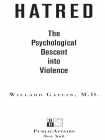Hatred, Willard Gaylin [best ebook for manga txt] 📗

- Author: Willard Gaylin
Book online «Hatred, Willard Gaylin [best ebook for manga txt] 📗». Author Willard Gaylin
Early people clustered together for the group survival demanded by our biology. They operated under the same genetic systems governing the same biological imperatives that influence us today. We can safely assume that they protected the helpless child, shared the tasks of providing food, clothing, and shelter for the community essential to the social animal that we are. They established group identities, group beliefs, group totems, and religions. They defined an “us” and thus, by definition again, an “other.” The groups, however, were small and the enemy was at hand.
Early enemies resided on the other side of the hill or mountain range in areas staked out by each group as its preserve, if not yet its nation. What was preserved were matters of life and death—hunting areas or grazing grounds. When the enemy raided your territory, he took with him the stuff of your group survival and, in the process, killed your people and raped your women. It would not be long before the very existence of the other would be perceived as a threat to survival. We hated the person who threatened the life of our loved ones, who murdered our children. Since travel was limited—picture life on a small island—the enemy was the same enemy that persisted for generations, and a true obsession was inevitable.
The hatred felt then and the suffering it caused were the same as that which we feel today toward those who threaten us and those we love. But in one sense, hatred seems to have been more justifiable, more rational in the days of the tribal strife. In those smaller environments where food had to be gathered almost daily, life was lived in a tenuous present and a zero-sum game for survival existed. Their feast and our famine were intricately linked. The very existence of the neighboring tribe, not just their isolated actions of cruelty, was a threat to the lives of our children.
The conflicts between neighbors that exist today are almost invariably more symbol than substance. Nevertheless, territory, whether the vast territory of Kashmir or the small Shaba’a farm-lands area that define the border between Israel and Lebanon, is used as a focus of enmity. Territory is particularly pertinent in that it demonstrates how land may be used as a rationalization and validating reason for sustaining hatred.
Territory has enormous emotional leverage in the minds of most individuals. It is concrete, can be visualized, and perpetuates the idea of desecrated “homeland.” Territory gives tangible focus to grievances that are rooted in altogether different dynamics. It helps define the enemy.
The Irish Protestant and the Irish Catholic are separated, defined really, by their religion, but it is territory that they fight over. If one could solve the political status of Northern Ireland in a way that seems to provide respect for each party and pays tribute to the real or imagined grievances of the past, one suspects that the religious differences would prove to be readily accommodated. The land has become the metaphor for that emotional condition called “national pride.” If our country is strong, somehow we must be stronger than the evidence of our daily life suggests. To a creature that lives in the world of its own perception, the symbol transcends actuality in importance. Human beings respond to the metaphor, for good and bad.
Think of the national jubilation verging on hysteria that seems the inevitable response to a country’s winning the World Cup in soccer. Our team—composed of disadvantaged people like us—has vanquished, indeed humiliated, the mighty. Never mind that it is only a game, and the moment that it is over, we must resume our impoverished lives. On the field of games and through the imaginative power of group identification, we have triumphed. An economically struggling country goes wild over winning a soccer match, as though it were the discovery of vast reserves of oil, and in the process actually feels more joy and pride. The World Cup places them at the top of the heap, if only symbolically and if only for moments.
Everywhere in the modern world where traditional enmities exist—Ireland, the Middle East, Kashmir, the Sudan—there is a division into self and others that focuses on territory. And everywhere the territory will turn out to be a symbol.
The Burundi-Rwanda wars are particularly devastating examples of long-term battles over largely symbolic territory. The massacres between Hutu and Tutsi occurred time and again over decades, resulting in the slaughter of hundreds of thousands. It is hard to identify a starting point for the conflict. The intermingling of these people extends back at least a half century, but beyond that little can be verified.61 Popular knowledge has it that Tutsi cattle herders migrated south from their homes in Ethiopia into the Great Lakes area then occupied by the Hutus. This migration set the stage for a primary claim to the area by the Hutus, reminiscent of some of the rhetoric in the Israeli-Palestinian conflicts, as to who “got there first.” Current scholarship indicates that there is no proof that the Hutus’ claim is true. Revisionist histories exist on both sides, yet what is clear is that a conflict between the Hutu and the Tutsi has existed over hundreds of years—preceding colonization, although undoubtedly exacerbated by it. The conditions of the recurring massacres and the rationalizations for them would change with each episode of destruction. But a traditional rivalry over land existed and serves as a classic example of tribalism at its worst.
With the Hutu-Tutsi conflicts, the occupations of common grounds and the slaughter increased and the pace of enslavement of the enemy accelerated with each shift of the power struggle. The withdrawal of





Comments (0)